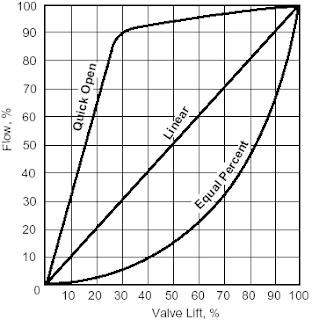A
valve positioner is used in combination with a
valve actuator to precisely position a valve so that optimum flow accuracy may be achieved. The positioner does this by measuring a the process variable, comparing it to a desired condition (set point) and then pneumatically, electrically, or hydraulically changing the valve disc, globe, plug or ball position until the difference between the set point and actual position is zero.
Valve positioners are key elements in a closed loop control system where the final control element is a
valve. They assist in maintaining tight control, overcoming the realities of imprecise calibration, differential pressure across the valve, valve wear and a host of other process control challenges.
A valve positioner responds to a signal from some type of master control system, typically a distributed control system (DCS), a programmable logic controller (PLC), or PID controller. The control system reads a signal from a process sensor (
flowmeter,
temperature sensor,
pressure sensor, etc...) and compares that reading to the desired setpoint. A corrective signal, based on the difference, is provided to the valve positioner which re-adjusts (if necessary) the valve position to bring the system in to equilibrium.
Valve positioners are available with pneumatic, electrical, electro-pneumatic, and digital operation. Here is a brief description of each:
Pneumatic
Pneumatic positioners receive pneumatic signals (3-15 or 6-30 PSIG). The positioner then throttles supply air to the valve actuator to move the valve to the required position. Pneumatic positioners are intrinsically safe and can provide a large amount of force to close a valve.
Electric
Electric valve positioners receive an electric signal, usually 4-20 mA, 1-5 VDC, 2-10 VCD or 0-10 VDC and generally drive the motors in
electric actuators. They perform the same function as pneumatic positioners do, but use electricity instead of air pressure as an input signal.
Electro-Pneumatic
 |
Electro-pneumatic Positioner
(PMV) |
Electro-pneumatic valve positioners contain internal I/P (current to pneumatic) modules that converts the electrical input signal to a pneumatic output (4-20 mA to 3-15 PSIG for instance). Very similar to a pneumatic positioner except that its input is electrical.
Valve positioners are used throughout the process industries including power, pharmaceutical, chemicals, oil and gas, food and beverage, pulp and paper, refining and petrochemicals, pipelines, and many other processes.
For more information on valve positioners, contact Swanson Flo by visiting
https://swansonflo.com or by
calling 800-288-7926.













